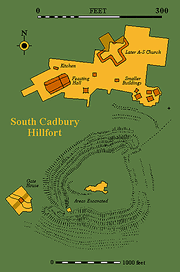Traditions[]

John Leland, who was a King’s Antiquary to Henry VIII in 1542, wrote a famous theory about the existence of Camelot. He wrote
- "Right at the South end of South Cadbury Church stands Camelot. This was once a noted town or castle, set on a real peak of a hill, and with marvellously strong natural defences..... Roman coins of gold, silver and copper have been turned up in large quantities during ploughing there, and also in the fields at the foot of the hill, especially on the East side. Many other antiquities have also been found, including at Camelot, within memory, a silver horseshoe. The only information local people can offer is that they have heard that Arthur frequently came to Camelot."
Leslie Alcock's Cadbury Excavation[]

Based on Leland's association with the existence of Camelot in Cadbury, Leslie Alcock and the others that worked with him came up with two questions to answer during their excavation:
- Was Leland reporting tradition about Cadbury which he found present in the folklore of that region; or was he making attributions and identifications of his own?
- What historical reality might lie behind such folklore or such identifications? Had there ever been a place like Camelot, or a man like Arthur in the romances?
Historical Records[]
According to Alcock's research, historical reality shows that Arthur is in no way linked to Camelot. Alcock had to decipher which parts of the stories told about Arthur were recorded within living memory and which stories were supposed to be historical. There are two noted events in history that were recorded in the Welsh Annals. Arthur took part in 1) the Battle of Mount Badon and 2) the Battle of Camlann involving Arthur and Modred (where they apparently perished). This work records Arthur as a genuine person, and a great person at that, but he appears as a soldier, not a king. However, in general, many modern historians are quite sceptical concerning the reference to Arthur in the Welsh Annals and also in the Historia Brittonum.
Results of the Excavation[]
During the excavation, no persona relics of Arthur could be found. But before the excavation began the Camelot Research Committee had emphasized to Alcock that no evidence of his existence was to be expected. It was found that Arthur could be the successor of Ambrosius Aurelianus. No reason was found to connect Cadbury with Ambrosius’s campaigns, because there is historical evidence that he was already an eminent soldier by AD 437, so he could have most likely retired before Cadbury was refortified in the 470s. But the date would fit Arthur, especially if the battle at Badon was in AD 490 or 499.
Alcock and those working with him could not find Camelot, but did gain knowledge of the material background of the Arthurian period. A gate-tower and timber mill were found during the excavation.

Example of the gate-tower
Whether Arthur was personally connected to Cadbury or not, Cadbury is still the perfect illustration of the kind of defended base he could have used during that time.
References[]
- Alcock, L 1972 By South Cadbury Is That Camelot... (New Aspects of Antiquity). Thames & Hudson, London. ISBN 0-500-39011-8.
- Ford, D. N. (2001). Cadbury Castle. Retrieved 08 06, 2009, from Early British Kingdoms: http://www.earlybritishkingdoms.com/archaeology/cadbury.html
